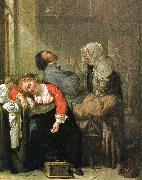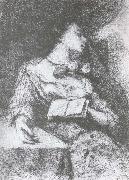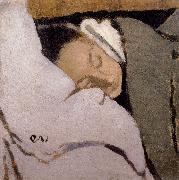
Oil On
Canvas, Real Flavor of Old Masters
|
Jacob Duck
|
|||
|
|
|||
| 1600-1667 Dutch Jacob Duck Location Dutch painter and etcher. He was long confused with Jan le Ducq (1629/30-76). In 1621 he was listed as an apprentice portrait painter in the records of the Utrecht Guild of St Luke. His teacher was probably Joost Cornelisz. Droochsloot (1586-1666). The St Job Hospital in Utrecht acquired a Musical Company by him in 1629. By 1630-32 he was a master in the guild. Like Pieter Codde, he painted guardroom scenes (kortegaerdjes), for example Soldiers Arming Themselves (c. 1635; New York, H. Shickman Gal., see 1984 exh. cat., no. 36) or the Hoard of Booty (Paris, Louvre), in which the figures and their interactions are apparently full of underlying symbolic meaning. He also painted merry companies (e.g. c. 1630; Names, Mus. B.-A.) and domestic activities, such as Woman Ironing (Utrecht, Cent. Mus.), employing motifs perhaps symbolic of domestic virtue. He placed his figures in high, bare interiors in which the deep local colours of the foreground stand out well against the cool, greyish-brown background. Only a few of his etchings are known (Hollstein, Dut. & Flem., vi, pp. 9-11), depicting figures in contemporary dress, for example Young Gentleman with Broad Hat and Cloak (Hollstein, no. 10) or Virgin and Child with Magi (nos 1-4). Between 1631 and 1649 Duck presence is documented in Utrecht, Haarlem and Wijk bij Duurstede. Afterwards, and probably by 1656, he was living in The Hague. He was buried at the monastery of St Mary Magdalene in Utrecht. | |||
|
|
|||
|
|
Sleeping Woman Jacob Duck1.jpg Painting ID:: 1009 Visit European Gallery |
||
Height Width |
INS/CM |
||
|
X |
|
||
|
|
|||
|
Gustave Courbet
|
|||
|
|
|||
| 1819-1877 French Gustave Courbet Locations was a French painter whose powerful pictures of peasants and scenes of everyday life established him as the leading figure of the realist movement of the mid-19th century. Gustave Courbet was born at Ornans on June 10, 1819. He appears to have inherited his vigorous temperament from his father, a landowner and prominent personality in the Franche-Comte region. At the age of 18 Gustave went to the College Royal at Besancon. There he openly expressed his dissatisfaction with the traditional classical subjects he was obliged to study, going so far as to lead a revolt among the students. In 1838 he was enrolled as an externe and could simultaneously attend the classes of Charles Flajoulot, director of the ecole des Beaux-Arts. At the college in Besançon, Courbet became fast friends with Max Buchon, whose Essais Poetiques (1839) he illustrated with four lithographs. In 1840 Courbet went to Paris to study law, but he decided to become a painter and spent much time copying in the Louvre. In 1844 his Self-Portrait with Black Dog was exhibited at the Salon. The following year he submitted five pictures; only one, Le Guitarrero, was accepted. After a complete rejection in 1847, the Liberal Jury of 1848 accepted all 10 of his entries, and the critic Champfleury, who was to become Courbet first staunch apologist, highly praised the Walpurgis Night. | |||
|
|
|||
|
|
Sleeping woman new20/Gustave Courbet-724569.jpg Painting ID:: 55607 Visit European Gallery |
mk242 1849 47x30cm | |
Height Width |
INS/CM |
||
|
X |
|
||
|
|
|||
|
Henri Matisse
|
|||
|
|
|||
| French Fauvist Painter and Sculptor, 1869-1954 Henri Matisse is considered the most important French artist of the 20th century and, along with Pablo Picasso, one of the most influential modernist painters of the last century. Matisse began studying drawing and painting in the 1890s. A student of the masters of Post-Impressionism, Matisse later made a reputation for himself as the leader of a group of painters known as Les Fauves. An ironic label given to them by a critic, the name reflected Matisse's aggressive strokes and bold use of primary colors. In 1905 Matisse gained sudden fame with three paintings, including Woman with the Hat, purchased by the wealthy American ex-patriot Gertrude Stein. Beyond painting, he worked with lithographs and sculpture, and during World War II he did a series of book designs. Later in his career he experimented with paper cutouts and designed decorations for the Dominican chapel in Vence, France. Along with Picasso, | |||
|
|
|||
| This artist (Henri Matisse) is not available now. | |||
|
|
|||
|
Edouard Vuillard
|
|||
|
|
|||
| 1868-1940 French Edouard Vuillard Galleries Jean-Edouard Vuillard, the son of a retired captain, spent his youth at Cuiseaux (Saone-et-Loire); in 1878 his family moved to Paris in modest circumstances. After his father\'s death, in 1884, Vuillard received a scholarship to continue his education. In the Lycee Condorcet Vuillard met Ker Xavier Roussel (also a future painter and Vuillard\'s future brother in law), Maurice Denis, musician Pierre Hermant, writer Pierre Veber and Lugne-Poe. On Roussel\'s advice he refused a military career and entered the Ecole des Beaux-Arts, where he met Pierre Bonnard. In 1885, Vuillard left the Lycee Condorcet and joined his closest friend Roussel at the studio of painter Diogene Maillart. There, Roussel and Vuillard received the rudiments of artistic training. | |||
|
|
|||
|
|
Sleeping woman new22/Edouard Vuillard-885477.jpg Painting ID:: 65915 Visit European Gallery |
mk288 1892 Oil on canvas painting 26.8 x 26.8 cm Private Collection, Washington, DC | |
Height Width |
INS/CM |
||
|
X |
|
||
|
|
|||









